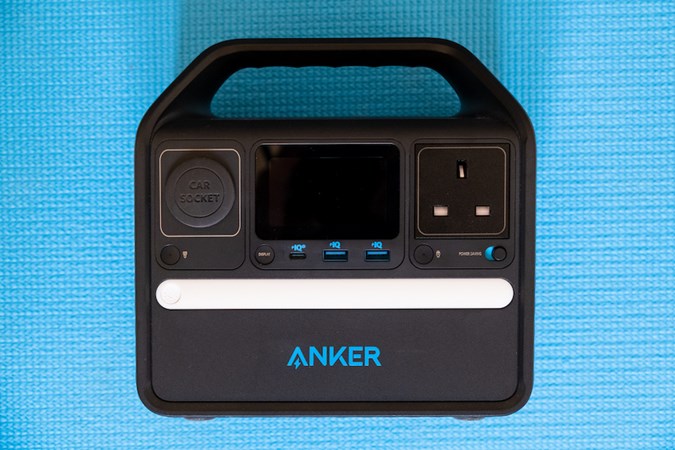It’s widely known that spending time in the great outdoors is good for the soul. Whether plodding around the garden or wild camping in the Scottish Highlands, getting outside and soaking up some rays is an absolute delight. The only problem is that much of the other stuff we’ve come to rely on – like smartphones and smartwatches, cameras, tablets, laptops, GPSs – is reliant on electricity.
While a small external powerpack might keep your gadgets topped up on a hike or end-of-work commute, these pocketable power sources do little for anyone with multiple items or families on the move. That’s where portable power stations like the Anker 521 PowerHouse Power Station come in.
The Anker 521 power station is an entry-level portable power carrying five outlets: one car socket, one three-pin UK socket, one fast-charging USB-C and two fast-charging USB-A. The 521 also has a lamp bar on its front and boasts a Power Saving mode which automatically cuts power to a device once fully charged, preventing the station from needlessly pumping out power.
At 256Wh, the Anker 521 can recharge handheld devices, laptops, cameras, and drones. It will power anything rated up to 200w, such as fans or a mini-fridge.
The feature list of the 521 is promising, but as an entry-level item that sits at the budget end of the market, can it deliver?
This article was originally published on 22/06/2022. We’ve checked back to update the links and change some formatting, so the date at the top of the page may not match up. We have corrected a claim made about the Anker Solar Panel. All other words and the score of the original review remain unaltered.
There and back again

There are two (obvious) things that a portable power station needs to be: the first is portable. On this, the Anker 521 certainly delivers. At around 4.3kg in weight and measuring roughly 21cm tall and long, it’s comparable to a small car battery.
The test for the portability of the 521 was on a car journey from Peterborough to Edinburgh. The 2007 Punto was far from well equipped with power outlets, and we needed to keep an iPhone (aka the sat nav) and an Android (aka the jukebox) topped with juice. On top of this, I’d forgotten to charge my camera batteries, so the UK mains plug came in handy here.
The Anker sat unobtrusively in the passenger footwell, leaving plenty of space for comfort on the six-hour bank holiday drive. Its small size and light weight also meant that it could be shifted around easily, at times being passed with one hand from the front to the back of the vehicle, and vice versa.
The second (obvious) thing a power station needs to do is deliver power. Again, the Edinburgh trip provided plenty of opportunities.
From one full charge of the Anker 521, I was able to; keep two smartphones topped up in the car (both ways); recharge two 1200mAh camera batteries; maintain the charge of an Apple MacBook Air for three days (used for streaming and editing photographs with Lightroom). When I hit my home turf, the Anker 521 displayed around 30% charge remaining. Not bad in the slightest.
While this test is anecdotal and far from scientific, it demonstrated to me the flexibility of the Anker 521 and has given me great confidence in its capabilities.
There’s no doubt that the Power Saving mode of the Anker 521 provided the station with excellent efficiency. Whenever an item is plugged into the 521, the remaining hours of power are displayed. This figure is based on the current consumption of power, so will dip considerably when an empty device is attached.
As soon as capacity is reached with Power Saving activated, the number shoots back up, with the Anker 521 only dripping charge in now and again to keep a connected device at 100%. This ensures that the 521 doesn’t waste any of its resources.
In short, it’s a big tick next to both portability and power.
Free as a bird

From my testing, I have no reason to doubt the claims made by Anker as to the 521’s capacity to power certain items for a certain number of times, whether it’s a smartphone 20 times, a camera 15 times, a laptop four times or a mini-fridge for five hours. The LiFePO4 batteries that Anker has packed into its shell are wonderful.
After ascertaining this, my main worry turned to use: as in, when would someone like me use a thing like this? I like to camp, but only get away maybe two or three times a year. I often take long car journeys, but mostly the single plug in the car does the trick and an Air BnB is waiting at the other end. How can a normal bod like me justify spending nearly £300 on such a gadget?
Maybe it’s time I let you know where I’m writing this review. I’m in my garden, sitting at a patio table working on a MacBook. I’ve been here for three hours, and the 521 is sat at my feet, keeping my laptop at 100% via the USB-C output. According to the display, I’m consuming 7w, and I’ve got over 30 hours of charge remaining. If I plug my phone in to charge, it drops to 22.5 hours.
This isn’t the first time I’ve done this. A few days ago, my partner joined me on the patio with a weak-batteried Windows laptop. We managed a full day without any hassle from low-battery warnings.
Previously, I used the 521 to help with DIY. The bright and kind-on-the-eyes lamp was perfect for lighting utility cupboards for hours at a time. The light was of such a quality that I would have no hesitation reading a book by it when camping. In fact, I have no hesitation in adopting the Anker 521 Power Station into my holiday kit fully and completely. I’ve already booked a campsite, saving myself a little cash by feeling free to choose pitches without electric hook-up, confident the 521 will see me through (and take up next to no room in the trolley).
If you’re someone living your best #VanLife, complete with the luxury of convenient showers and s’mores kits, the Anker 521 would also be a valuable addition, being chargeable from an adaptor during a drive, and ready to power smaller gadgets in the evening.
Of course, all uses I’ve mentioned above are geared more towards luxury and holidays, but a fully charged Anker 521 is also a valuable tool to have in case of a power cut or similar issue.
For those looking to transform the Anker 521 into a sustainable energy power station, it can be coupled with the Anker 625 Solar Panel for sun-based charging. Just note that this will set you back the best part of £300.
The downsides

I do not need a car socket plug. The only item I own that requires such a connection is my dash cam and that, unsurprisingly, stays in the car. I can think of using this socket for an in-car Bluetooth-to-FM adapter or small digital inflator. Maybe it will work for others, but I would much rather see an additional UK three-pin socket, adding far more utility.
In truth, this is a downside only realised in reflection. While out using the Anker 521 in real-world practice, my partner and I never found ourselves scrambling against each other for power outlets from the Anker 521. If you are desperate for another UK plug, the larger Anker 400 or Anker 535 carries two.
Moving forward, I can see an issue with only one USB-C outlet, however. My iPhone comes with a USB-C compatible charging cable as standard, whereas my partner uses a relatively new Android which still requires USB-A ports. As the world moves on from this technology and USB-C takes its place as the ubiquitous connection port, users of the 521 might find themselves competing for its single outlet. Of course, a relatively cheap aftermarket cable can solve this, but it would be nice to see Anker, a well-established tech company, pre-empt the impending change.
Price and competition
At the time of writing, the Anker PowerHouse 521 is available through Amazon UK for £299.99. Though not a cheap item, this is considered a budget or entry-level power station. Its main rival is the industry-leading Jackery Explorer 240, which has an RRP of £259.99.
Though physically comparable, the Jackery has slightly less capacity and no support for USB-C or fast-charging. It is compatible with the Jackery SOLARSAGA 100 solar panel, which can have the Explorer 240 fully charged in 5.5 hours (though it will cost you an extra £250 or more).
Verdict
I’m very taken with the Anker 521 Portable Power Station. It fulfils its brief in full, delivering great amounts of recharging power in a very portable package.
While there are a few downsides to the device (car socket, only one USB-C, expensive solar panel) in practice, the Anker 521 operates without fault. It provides welcome flexibility when camping, working with laptops and cameras in a remote location, or just soaking up rays at the end of their garden.
Score: 4/5
Anker 521 PowerHouse Portable Power Station

Price: RRP £299.99 | VIEW OFFER
Pros:
• Great capacity and portable
• Power Saving function
• USB-C charging
Cons:
• Car socket surplus to requirements for some
• Only one USB-C port
• Expensive solar panel – but this is something seen across the industry
Specficiations
Cell Capacity 256Wh
Lifecycle 3000 cycles to 80%+ capacity
Operating Temperature 32°F-104°F / 0°C-40°C
Ambient Temperature 32°F-104°F / 0°C-40°C
Size 21.6×21.14×14.4cm / 8.5×8.32×5.67inches
Weight 4.34kg / 9.57lbs
Input:
DC Input 11-28V⎓5.5A (65W Max)
USB-C Input 5V⎓3A / 9V⎓3A / 15V⎓3A / 20V⎓3A (60W Max)
Output:
Car Charger Output 12V⎓10A
AC Output 220-240V~, 0,9A Max, 50Hz, 200W
USB-A Output 5V⎓3.6A (2.4A Max Per Port)
USB-C Output 5V⎓3A / 9V⎓3A / 15V⎓3A / 20V⎓3A (60W Max)
More items to consider:
Jackery Explorer 240 Power Station, RRP £259.99
Anker 535 Portable Generator, RRP £499.00
Swarey S500 Power Station, RRP £459.99
How the product was tested:
The product was used over the course of a month. I used the Anker 521 to charge products while in a car, around the house and in the garden. Use time varied from a few minutes to entire days, both inside and out.
Sign up to the Parkers Newsletter to keep up to date with more of the latest reviews, news, and recommendations from the Parkers team.
Just so you know, whilst we may receive a commission or other compensation from the links on this page, we never allow this to influence product selections – read why you should trust us.
Just so you know, we may receive a commission or other compensation from the links on this website - read why you should trust us.












